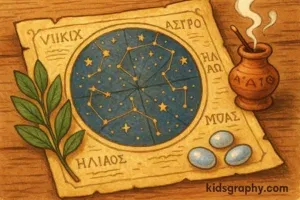In the heart of ancient myths where gods ruled the skies and heroes fought epic battles, one figure soared above all in triumph—Nike, the Greek goddess of victory. Known for her wings and swift grace, Nike represented not just success in war but victory in all aspects of life, including sports, contests, and personal challenges.
Let’s explore who Nike is in Greek mythology, her divine family, symbols, and the powerful legacy that still influences the modern world today.
Read More: Ares in Greek Mythology: God of War and Fury
Who Is Nike in Greek Mythology?
Nike (pronounced Nye-kee) is the ancient Greek goddess of victory. She is not just a symbol of success in battle, but also the spirit of achievement, competition, and glory.
In Greek myths, Nike:
- Flew across battlefields to crown victors with glory
- Brought honor and recognition to both gods and mortals
- Served as a loyal companion to Zeus, the king of gods
Her presence meant triumph, and she was always there to celebrate moments of heroic greatness.
Read More: Perseus in Greek Mythology: Hero, Slayer of Medusa
Nike’s Divine Family and Origins
Nike was born to Pallas, a Titan associated with warcraft, and Styx, the goddess of the underworld river of oaths.
She had three powerful siblings:
- Kratos – personification of strength
- Bia – personification of force
- Zelus – personification of zeal and rivalry
Together, they stood with Zeus during the Titanomachy, the great war between the Titans and Olympians. Because of their loyalty, Zeus made them his constant companions. Among them, Nike stood out as the symbol of divine success.
Read More: Athena in Greek Mythology: Goddess of Wisdom & War
The Role of Nike in Greek Mythology
Nike played a unique role in mythology. She was not a goddess of war like Athena, nor of beauty like Aphrodite. Instead, her power came from what followed after battle—victory.
Her main roles included:
- Rewarding victors in war, sports, and competitions
- Flying across the skies to announce success
- Carrying a wreath or palm branch, symbols of triumph
- Often crowning the victorious with laurel wreaths
She didn’t start wars—she celebrated those who overcame them.
In artwork, she is almost always winged and fast-moving, reminding us that victory can be fleeting if not respected.
Read More: Hephaestus: The Amazing Greek God of Fire and Forging!
Nike in Ancient Greek Culture and Worship
Although Nike did not have many temples dedicated solely to her, she was deeply respected. One of the most famous examples of her presence is in Athens, where she was worshipped alongside Athena.
The Temple of Athena Nike on the Acropolis honors both goddesses. In this context, Nike is seen as:
- The bringer of military victory
- A guardian of the city’s power and success
- A constant reminder of what must be protected
In art, Nike was everywhere:
- On coins, where she symbolized the strength of a city
- In sculptures, especially winged statues in temples and stadiums
- On vases and shields, showing heroes receiving Nike’s favor
Symbols and Appearance of Nike
Nike is almost always shown with:
- Wings, symbolizing speed and divine movement
- A wreath, which she places on the heads of winners
- A palm branch, another symbol of peace after success
- Occasionally, a trumpet, to announce victory loudly
These symbols of Nike have lasted for thousands of years, and you’ll still see them today—especially in sports, art, and fashion.
Read More: Pandora in Greek Mythology: The First Woman’s Curse
Nike in the Modern World
Even if someone doesn’t know the myths, they’ve almost certainly heard of Nike—thanks to one of the world’s biggest athletic brands. The Nike company, named after the goddess, uses her swoosh symbol to represent motion, success, and performance.
The famous Winged Victory of Samothrace, a stunning sculpture of Nike, stands in the Louvre Museum. With her wings stretched and robes blowing in the wind, she still inspires people with the idea of glorious achievement.
Nike isn’t just a figure from the past. She is alive in every race won, every mountain climbed, and every moment when hard work leads to triumph.
Nike vs. Athena: Not the Same Goddess
Because both Nike and Athena are linked to war and wisdom, many people confuse them. But in Greek mythology, they are very different.
- Athena is a warrior goddess, known for her wisdom, strategies, and protection of cities.
- Nike is the personification of victory itself, often appearing at the end of battles or competitions.
In some myths, Nike is seen beside Athena, especially in Athens where they shared the temple of Athena Nike. But even here, Athena is the protector; Nike is the reward.
While Athena plans and fights, Nike celebrates and honors. They work well together, but they are not the same.
Read More: Persephone in Greek Mythology: Queen of the Underworld
The Winged Victory of Samothrace
One of the most famous statues in the world, the Winged Victory of Samothrace, is believed to represent Nike. Discovered in 1863, it dates back to around 200 BCE and is now in the Louvre Museum in Paris.
Even though the statue is missing its head and arms, it remains one of the most powerful images of triumph ever sculpted:
- Nike is shown standing on the prow of a ship
- Her wings are spread wide
- Her garments are blown by the wind, suggesting movement and momentum
This statue celebrates a naval victory and captures the spirit of glory and motion like no other. It’s one of the greatest examples of Nike’s timeless influence.
Read More: Chaos in Greek Mythology: The First Being of Creation
Nike’s Influence on Sports and Society
In modern times, Nike is everywhere—especially in sports and competition.
- Olympic medals and trophies often feature Nike holding a laurel wreath
- The concept of a “personal best” or achieving victory through effort reflects her legacy
- Even today’s Nike brand slogan “Just Do It” fits the goddess’s spirit—bold action, swift reward
Nike’s presence in competitions shows that victory isn’t just about beating others—it’s about conquering yourself.
Nike in Roman Mythology
In Roman mythology, Nike was known as Victoria.
Victoria shared the same roles:
- Goddess of victory
- Appeared on Roman coins, shields, and victory arches
- Honored in military parades and temples
The name Victoria even lives on in words like “victory” and names like “Victoria” today.
Both Nike and Victoria show that humans have always valued the moment of triumph—that flash of glory after great effort.
Read More: Hera in Greek Mythology: Queen of the Gods
Final Thoughts: Why Nike Still Matters
Nike isn’t just a myth. She’s a universal idea—a symbol of hope, strength, and reward.
Whenever someone:
- Finishes a hard journey
- Wins a game or battle
- Achieves a goal they once thought impossible…
Nike is there, in spirit, reminding us that victory is possible—and beautiful.
More Stories: Nike in Greek Mythology
FAQ: Nike in Greek Mythology
Nike is the winged Greek goddess of victory. She represents success in battle, sports, and all forms of competition.
Nike rewards victors by crowning them with wreaths. She flies across battlefields and competitions to honor achievement and glory.
No. Athena is the goddess of war and wisdom, while Nike is the goddess of victory. They are separate deities but often appear together.
Nike is usually shown with wings, a laurel wreath, a palm branch, and sometimes a trumpet. These all represent triumph and success.
The Nike brand chose the goddess’s name to symbolize victory, speed, and athletic excellence—values that align with sports and performance.
Read More: Sirens in Greek Mythology: Deadly Voices of the Sea












